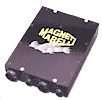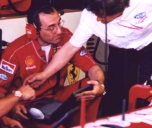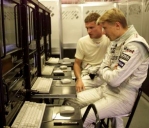Electronics
Every one of the 22 Formula One cars on the grid is dependent upon sophisticated electronics to govern its many complex operational systems. Each Formula 1 car has over a kilometre of cable, linked to about 100 sensors and actuators which monitor and control many parts of the car. Rarely a race goes by without a car retiring with electrical problems, indicating the important role that this technology has in modern F1 cars.
Engine Management
 The 800 bhp of a modern F1 engine is largely a result of a complex electronic control unit (ECU) that controls the many systems inside an engine so that they work to their maximum at every point around the lap. Engine mappings can change completely from circuit to circuit depending upon the nature of the track. At Monaco for instance, the engine control system will help the driver have more control on the throttle input by making the first half of the pedal movement very sensitive, and the latter half less sensitive. This means that the driver can have great control on the throttle for the twisty corners, so that it is easier to limit the acceleration out of corners so not to spin the wheels. At somewhere like Hockenheim, the driver has to jump on the throttle more out of the chicanes, rather than gradually applying full throttle. The accelerator will be set so that only a small movement will result in full engine acceleration. It is also possible to iron out any unplanned movements of the throttle such as when a driver travels over a bump and his foot may move slightly.
The 800 bhp of a modern F1 engine is largely a result of a complex electronic control unit (ECU) that controls the many systems inside an engine so that they work to their maximum at every point around the lap. Engine mappings can change completely from circuit to circuit depending upon the nature of the track. At Monaco for instance, the engine control system will help the driver have more control on the throttle input by making the first half of the pedal movement very sensitive, and the latter half less sensitive. This means that the driver can have great control on the throttle for the twisty corners, so that it is easier to limit the acceleration out of corners so not to spin the wheels. At somewhere like Hockenheim, the driver has to jump on the throttle more out of the chicanes, rather than gradually applying full throttle. The accelerator will be set so that only a small movement will result in full engine acceleration. It is also possible to iron out any unplanned movements of the throttle such as when a driver travels over a bump and his foot may move slightly.
The engine control system can cut out the jumps of the throttle and keep full throttle down the straight, even on bumpy tracks. This is all possible because there is no direct link between the engine and the accelerator. The accelerator position is sensed using an actuator, and this signal is then sent to the engine control system, from where it is passed onto the engine. An engine ECU is much more than a device for making the throttle more or less sensitive. The ECU controls the inlet trumpet height, fuel injection among other things to try to get the maximum torque out of the engine. In the modern world of electronics, the ECU monitors many of the engine parameters including RPM, to control the torque output from the engine. This means that the modern day F1 accelerator acts more like a torque switch than a simple fuel input controller. F1 engines are so complex that they are designed to run in a small power band between 15000 - 18000 rpm, and the electronic monitoring and controlling of the engine parameters are crucial in keeping the engine in this working region. This working region is where torque is virtually constant, and letting the engine get below the lower limit would see a sudden drop off of torque, until the engine began to rev in the working region, where the torque would come in suddenly again, probably promoting wheelspin.
Other ECU functions
The ECU also controls the clutch, electronic differential and and the gearbox. The clutch is controlled by the driver to start the car from rest, but not during gear changes. Although the driver modulates the throttle like on a road car (although with his hand) there is no direct link to the clutch - it is all electronic. The ECU engages and disengages the clutch as the driver moves the paddle behind the steering wheel. The ECU will also depress the clutch if the car spins to stop it stalling. The FIA introduced the anti-stall device in 2000 to prevent cars stalling after a spin and being left dangerously i the middle of the track. The ECU is also responsible for changing gears in under 100 milliseconds. The electronics allow the driver to keep his foot flat on the throttle during up-shifts, and blip the throttle on down-shifts to match engine speed with transmission speed to prevent driveline snatch. The final area controlled by the ECU is the differential. Modern F1 cars have electronic differentials which monitor and control the amount of slip between the rear wheels on entry and exit of corners. This is often adjusted for different driving styles to try to keep the rear end of the car in control during all phases of a corner.
 |
 |
Data acquisition - Telemetry
Every aspect of the car, whether it be speed, brake and engine temperature, suspension movements, ride height, pedal movements and g-force are measured and controlled from the pit whilst the car is out on the track. Teams usually take over 30 kg of computer equipment to each Grand Prix just to help the drivers and engineers to find the right set-up and cure any car problems. An F1 car has two types of telemetry: The first is a microwave burst that is sent to the engineers every time the car passes past the pits. This data burst can contain around 4 megabytes of information giving the engineers a vital insight into the state of the car. Another 40 or so megabytes can be downloaded from the car when it returns to the pits, so no part of the car goes 'unwatched'. The information is downloaded by plugging in a laptop computer to the car, in a socket usually located in the sidepod or near the fuel filler. The second type is a real time system which transmits smaller amounts of information, but this time it is in 'real time'. This means the car is constantly sending out information such as its track position and simple sensor readings.
 The telemetry is sent to the pits via a small aerial located on the car, usually located on the sidepod nearest to the pits. Some teams have placed the transmitter in the wing mirror that passes closest to the pits to do away with an extra aerial. When the cars returned to the pits, a small box was put over the wing mirror to prevent anyone being harmed by the radiation given out by the transmitter. This telemetry data is vital to the engineers both during the race and practice. A huge bank of computers at the back of the garage will process the information sent by the cars whilst they are on the track, and from this complex information, the team members can quickly tell whether the car is operating correctly. During a race for example, readings such as the engine temperature and hydraulic pressure are carefully examined lap by lap to ensure the car is not about to suffer any major failure. If any of one of these readings becomes varied from the normal operating state, the engineers can tell the driver to use less engine revs or drive more steadily to try to prevent a failure. Teams use software provided by their IT partners (Hewlett Packard, Compaq, TAG Electronics) that will display all of the gathered information on a screen that can be easily interpreted by the engineers. McLaren have gone a step further than most teams, developing their own system called ATLAS. Standing for Advanced Telemetry Linked Acquisition System, ATLAS displays graphs of each of the cars systems in real time at all parts of the track. Although most of the top teams have systems similar to ATLAS, it is believed that McLaren's system is one of the most advanced in F1.
The telemetry is sent to the pits via a small aerial located on the car, usually located on the sidepod nearest to the pits. Some teams have placed the transmitter in the wing mirror that passes closest to the pits to do away with an extra aerial. When the cars returned to the pits, a small box was put over the wing mirror to prevent anyone being harmed by the radiation given out by the transmitter. This telemetry data is vital to the engineers both during the race and practice. A huge bank of computers at the back of the garage will process the information sent by the cars whilst they are on the track, and from this complex information, the team members can quickly tell whether the car is operating correctly. During a race for example, readings such as the engine temperature and hydraulic pressure are carefully examined lap by lap to ensure the car is not about to suffer any major failure. If any of one of these readings becomes varied from the normal operating state, the engineers can tell the driver to use less engine revs or drive more steadily to try to prevent a failure. Teams use software provided by their IT partners (Hewlett Packard, Compaq, TAG Electronics) that will display all of the gathered information on a screen that can be easily interpreted by the engineers. McLaren have gone a step further than most teams, developing their own system called ATLAS. Standing for Advanced Telemetry Linked Acquisition System, ATLAS displays graphs of each of the cars systems in real time at all parts of the track. Although most of the top teams have systems similar to ATLAS, it is believed that McLaren's system is one of the most advanced in F1.
